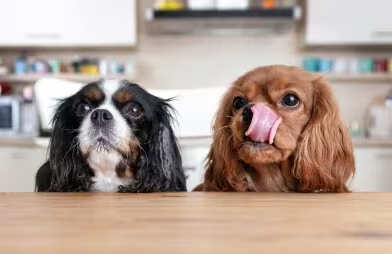Weighty questions: How do you make sure your dog eats well and stays fit?

The question “What do you feed a dog?” might seem like a simple one.
The answer, of course, is dog food. But then there are a lot of follow-up questions: What kind of dog food? How much? How often? How can you tell if your dog’s diet is balanced and nutritious over the course of their life? (And we haven’t even touched on the subject of treats.)
You have questions, and we have answers. We spoke to Dr. Garrett Schuilenberg, a veterinarian, who as part of his training, understands the science of canine nutrition and weight control. He answered some of the frequently asked questions we get about keeping your dog healthy and happy through proper nutrition and diet.
Dog food: what’s in this stuff, anyway?
Good news: If you’re feeding your pup high-quality kibble, wet food, or commercially made frozen raw dog food, all of their nutritional basics are covered. Nutritional and labelling requirements are set by the Association of American Feed Control Officials (AAFCO), and serve as the standard for pet food manufacturers to produce and sell food that provides a complete and balanced diet.
“Kibble is made in factories where they have very finely tuned, [standards for] this much calcium, this much phosphorus, and whatever else to meet the needs that your dog has,” says Dr. Schuilenberg. “Honestly, if humans could eat dog kibble, I think a lot of us would be happier. A lot of us would be a lot healthier.”
That said, it’s not a particularly exciting diet.
“It's boring, right? And people feel bad about their pets eating the same meal every day for years,” he says. “But kibble is good in that regard. Everything is in there. It's been made to have everything in there.”
Dr. Schuilenberg adds that commercially manufactured raw food for dogs (available in our stores’ freezer section) have also evolved to be nutritionally complete in their design and makeup. Regardless of the style of food you’re giving your dog, he recommends looking for a label that says that the product meets AAFCO standards.

Doggy diet decisions
There are a lot of choices out there when you’re deciding on a diet for your furry BFF and it can be overwhelming. Dry dog food, wet dog food, raw dog food, or freeze-dried raw dog food? Which proteins are best? Beef? Kangaroo? What about grain-free? Schuilenberg says, for puppies, a diet primarily made up of kibble formulated for their specific growth stage is the best bet.
Perhaps surprisingly dogs can eat vegetarian diets, though Dr. Schuilenberg doesn’t recommend it unless there’s an allergy issue. “They’re often reserved for dogs with skin issues and things like that, where we're convinced that it's a food allergy. Another reason would be some sort of digestive issue where we can't find a kibble that they can digest.”
In adulthood, weight can become a concern for certain breeds as well as for less active dogs. Both portion control and foods formulated for weight control are tools to keep your pet a healthy weight.
Nutritionally speaking, though, Dr. Schuilenberg warns pet parents against anthropomorphizing—a term used when people attribute human traits, emotions, or intentions to non-humans (like pets).
“A lot of people are trying to eat less processed foods, eat more ‘holistically’. So I think that is sort of translated over to dogs,” he says, adding that a vegan diet might work for humans but it’s not usually the best option for dogs unless there is a vet-prescribed medical reason to avoid meat and animal products.

Why weight matters
Scientific studies have found that slim dogs live up to two years longer and experience the onset of age-related disease and illnesses (like osteoarthritis, other inflammatory diseases, and cardiovascular disease) later in life than overweight dogs.
Even with temporary conditions like heatstroke, slim dogs recover faster and more fully, while avoiding associated complications that can arise.
Monitoring your dog’s level of exercise (while creating opportunities for them to get out and play) is key and should be in tune with their feeding. For example, you may feed them a little less in the depths of winter if they’re not getting long walks.
Or top up their bowl with extra food in summer, if they’re spending more time and energy on doggy paddles around the lake or epic games of frisbee in the park. Just don’t forget to leave room for treats!
For more info on rotational feeding, ensuring your pet has a balanced diet, managing food allergies and more, check out our full guide to feeding your pet.









































